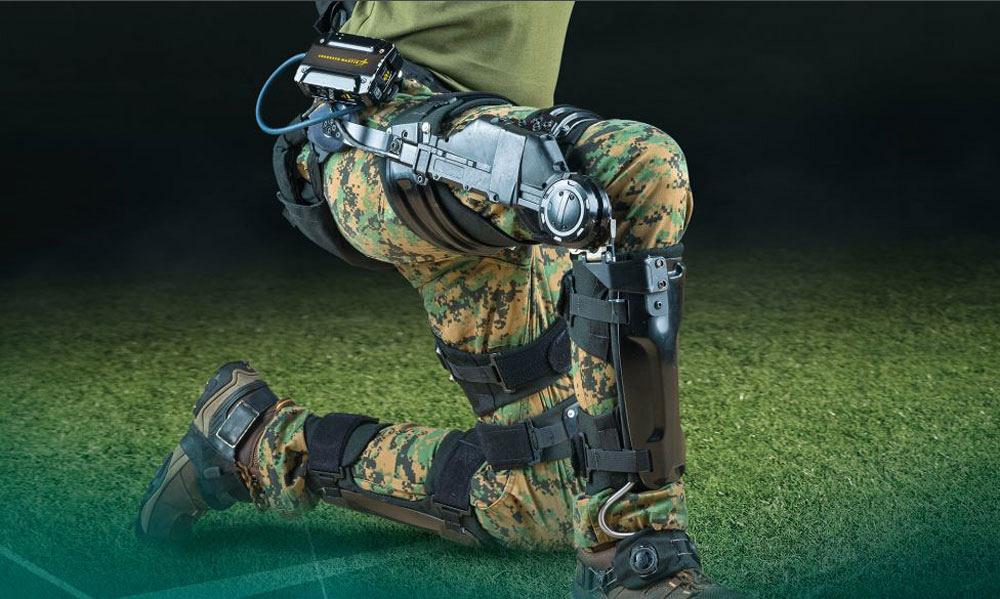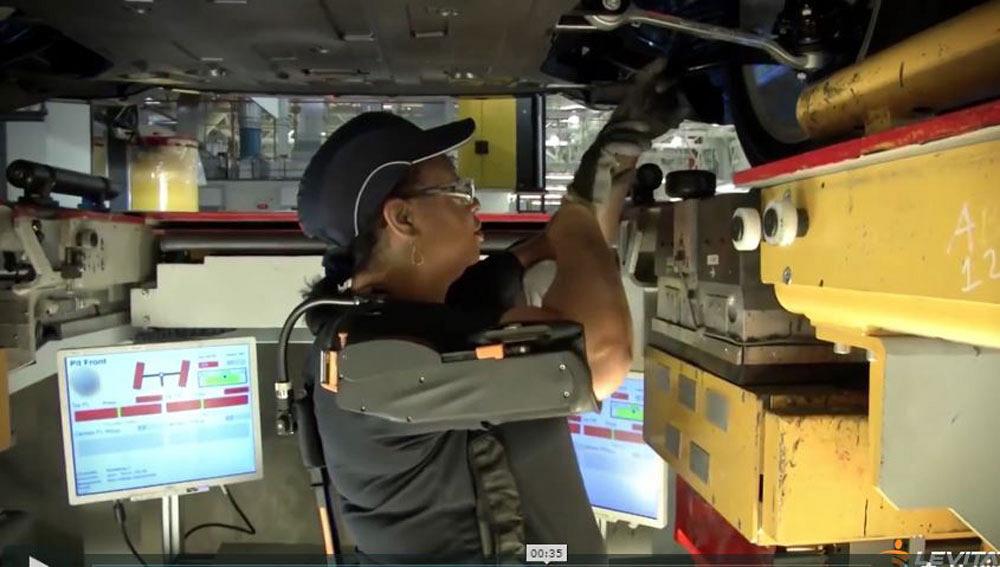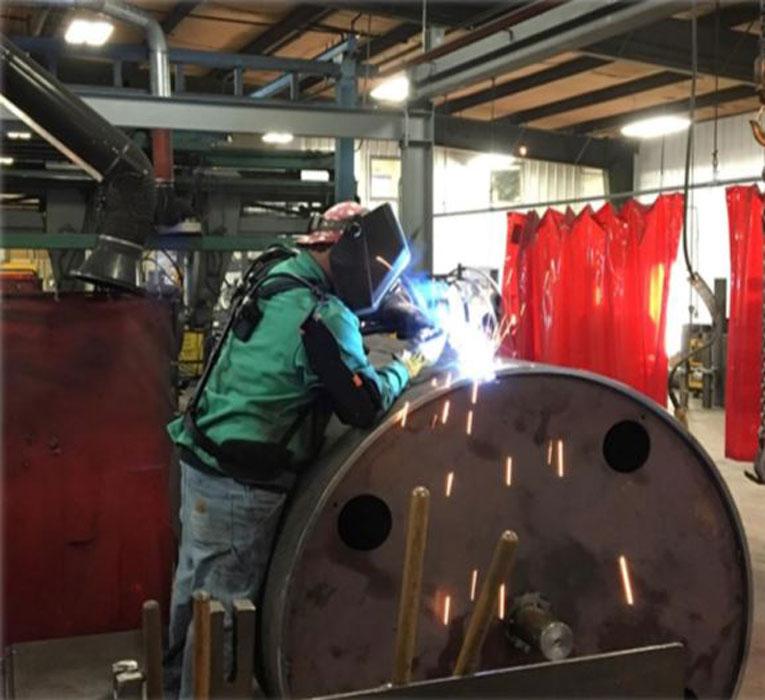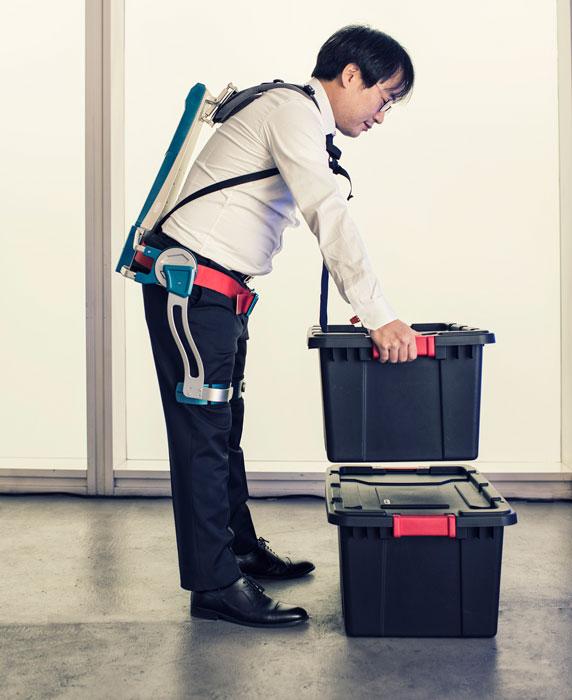Contributing editor
- FMA
- The Fabricator
- FABTECH
- Canadian Metalworking
Categories
- Additive Manufacturing
- Aluminum Welding
- Arc Welding
- Assembly and Joining
- Automation and Robotics
- Bending and Forming
- Consumables
- Cutting and Weld Prep
- Electric Vehicles
- En Español
- Finishing
- Hydroforming
- Laser Cutting
- Laser Welding
- Machining
- Manufacturing Software
- Materials Handling
- Metals/Materials
- Oxyfuel Cutting
- Plasma Cutting
- Power Tools
- Punching and Other Holemaking
- Roll Forming
- Safety
- Sawing
- Shearing
- Shop Management
- Testing and Measuring
- Tube and Pipe Fabrication
- Tube and Pipe Production
- Waterjet Cutting
Industry Directory
Webcasts
Podcasts
FAB 40
Advertise
Subscribe
Account Login
Search
Exoskeletons make assembly, finishing, joining less injurious, more productive
Wearable assists fight the repetitive motion injury battle
- By Kate Bachman
- February 1, 2019
- Article
- Assembly and Joining

The MATE exoskeleton from Comau is a passive technology based on a system of springs, leverage, and the shoulder kinematic chain that redistributes the arms’ weight to the back and stores energy in the springs. There is no need for a battery, and actuators reproduce the biomechanical structure of the shoulder.
According to the U.S. Occupational Safety and Health Administration (OSHA), musculoskeletal disorders (MSDs) affect the muscles, nerves, blood vessels, ligaments, and tendons. Workers in many different industries and occupations can be exposed to risk factors at work, such as lifting heavy items, bending, reaching overhead, pushing and pulling heavy loads, working in awkward body postures, and performing the same or similar tasks repetitively. Exposure to these known risk factors for MSDs increases a worker’s risk of injury.
Over time industrial workers can be affected or disabled by stresses from repetitive motion, carrying loads, and working in challenging positions. This work can result in severe injuries that require extended rehabilitation or specialized care.
Work-related MSDs are among the most frequently reported causes of lost or restricted work time.
According to the U.S. Bureau of Labor Statistics (BLS), MSDs accounted for 33 percent of all worker injury and illness cases in 2013. Examples are:
- Carpal tunnel syndrome
- Tendinitis
- Rotator cuff injuries (affects the shoulder)
- Epicondylitis (affects the elbow)
- Trigger finger
- Muscle strains and low-back injuries
Weight’s connection to repetitive motion is especially problematic because weight exacerbates the strain and therefore the severity of the injury.
Many metal fabricators recognize that reducing the stress and strain of repetitive-motion tasks not only reduces injuries and the costs associated with them, it improves the execution of the task. Many ergonomic devices have prevented MSD injuries and improved workers’ performance.
Magnetic lift assists are becoming more commonplace in the industrial workplace. Used to lift tools and parts, they can help turn a heavy task into a light one or even a weightless one.
Articulating arms such as die grinding arms, drilling arms, and tapping arms take the tool’s weight out of the task’s equation and help the diemaker, welder, or technician to control the drilling, tapping, or grinding motion. They improve accuracy and accelerate the operation in the process, because workers can concentrate on the task at hand rather than lifting the tool.
Hydraulic lift tables, pallet positioners, and container tilters allow workers to position work at the most comfortable, convenient height for easy, strain-free access, eliminatimg unnecessary bending, reaching, and stretching in machine feeding applications.
Weld positioners flip large workpieces to allow a welder to be in an optimal position to work and to avoid difficult and awkward positions that place greater strain on vulnerable body parts.

ONYX from Lockheed Martin is a powered, lower-body exoskeleton with artificial intelligence that augments human strength and endurance. The structure is designed to support and boost leg capacity for physically demanding tasks that require lifting or dragging heavy loads, holding tools or equipment, repetitive or continuous kneeling or squatting, crawling, and walking long distances.
One of the newest products to extend the concept of weight assistance is worn like personal protection equipment (PPE).
Exoskeletons are the latest ergonomic devices engineered to reduce fatigue and injury for workers exposed to repetitive motion and excess load. They are a wearable technology that can resemble anything from a backpack to athletic support braces to something right out of sci-fi.
Some have been developed specifically for industrial applications, while others have migrated from other segments such as military and medical.
They currently are being used in industry, especially in the automotive segment. Hyundai, Toyota, Ford, and BMW, to name a few, are employing them.
AIRFRAME™ Exoskeleton
Levitate Technologies, San Diego, introduced its AIRFRAME to the market two years ago. The lightweight, wearable technology is designed to relieve upper extremity muscle and joint strain and discomfort for professionals and skilled trade workers who are exposed to the repetitive elevation of their arms, the company states. The exoskeleton is low-profile, body-conforming, and light—5.5 pounds.
Applications. “This is primarily for the upper body—arms, shoulders, neck—for when people are lifting or working and reaching above their shoulders to work under cars or airplanes. This is not a lumbar support for picking something off the ground,” said Joseph Zawaideh, vice president of marketing and business development for Levitate.
“When you raise your arms over shoulder level, whether for welding, painting, or assembly, the weight of your arms and the weight of the tool that you’re holding are straining your shoulder, neck, and back muscles. When you do that repetitively throughout the day or even for as little as four hours a day, for any human being that will exceed a certain threshold and cause inflammation of those muscle groups. You are overusing your musculoskeletal system, and that can cause strain and possibly tears.
“And that is a very bad thing. Of course, those injuries have to be dealt with with surgery or physical therapy, which means taking time off from the workplace.”
How It Works. The AIRFRAME helps support the weight of the tool and even the worker’s arms. When the arms are raised, the support mechanism kicks in, and when the arms are lowered, the support mechanism disappears. This ergonomic support relieves tension on the shoulder, neck, and back of the skilled trade professional.
“Where does this load go? It goes down from the arm onto a rigid aluminum frame and down the back to the outside of the hips,” Zawaideh said. “So it’s almost like a backpacking backpack in that the load goes partly on the shoulders and mainly on the outside of the hips, bypassing the wearer’s spine. The outside of your hips can take that load onto your body core. It’s as though somebody behind you is holding up your arms as you load something in front of you at shoulder level, just taking the edge of it.”

Levitate Technologies’ AIRFRAME helps support the weight of the tool and even the worker’s arms when they are raised. It redistributes the load from the arm onto a rigid aluminum frame and down the back to the outside of the hips similar to they way a a hiker's backpack works. It is nonpowered and does not require electricity or software.
AIRFRAME is a mechanical device. It has no batteries, no gases, and no software. It comprises an aluminum frame, strings, pulleys, and cables. “It’s a piece of personal protective equipment. You put on your safety glasses, gloves, and your AIRFRAME,” Zawaideh said.
“This is a very elegant, lightweight, miniature exoskeleton that allows you to move freely. It doesn’t make you stronger. It doesn’t help you pick up stuff off the floor. Basically it’s a helping hand for people who work with their arms elevated all day.” The assistance is in the design of the apparatus rather than any sort of electrically powered motor.
The device lowers exertion levels by up to 80 percent, he added.
It is suitable for assisting an aging workforce as well as a preventive effort for younger workers.
“You put it on like you’re putting on a backpack. So you swing your arm straps just like a backpack, fasten the belt, pull down the support mechanism, and swing it under your right arm and swing the left one under your left arm. It takes less than 10 seconds.
“Think about changing light bulbs,” he continued. “After 20 minutes, you’d really start to feel that aching. Imagine if somebody came up behind you and just gave you a little support right below your elbow. That’s what this device does.”
It is light enough that workers can wear it all day long, he added.
The AIRFRAME has 80 global customers, including BMW, Toyota Motor Manufacturing, and John Deere.
MATE Exoskeleton
Comau SpA introduced its MATE wearable exoskeleton at Automatica 2018 in Munich (see lead image).
MATE technology aims to reduce fatigue and improve the quality of work by reproducing and enhancing the physiological movements of the upper limbs, according to Andrea Ivaldi, product marketing manager for Comau robotics and automation products.

Levitate Technologies’ AIRFRAME helps support the weight of the tool and even the worker’s arms when they are raised. It redistributes the load from the arm onto a rigid aluminum frame and down the back to the outside of the hips similar to how a backpacking backpack works. It is nonpowered and does not require electricity or software.
Applications. MATE originally was designed for vehicular underbody tasks during the finishing phase of assembly. However, it also can be effective for any task that requires the use of the upper limbs, specifically for those that require a flexion-extension of the shoulder, he added. Other applications are drilling, assembly of electrical appliances, and boxing and unboxing.
How It Works. The MATE exoskeleton reproduces the biomechanical structure of the shoulder. It alleviates the arms’ weight by ergonomically redistributing it to the back. The springs store the potential energy of the flexion and extension motion of the arm, and then reproduces the physiological movement of the shoulder.
“It is a totally passive exoskeleton technology based on a system of springs, leverage, and the shoulder kinematic chain. There is no need for a battery and actuators,” Ivaldi said.
“Our hypothesis is that MATE may reduce musculoskeletal injuries caused by repetitive movements of the upper limbs, because use of the device reduces the muscular effort of the muscles of the shoulder joint by up to 30 percent.” He noted that this is a hypothesis needing verification by long-term clinical studies.
ONYX™ Exoskeleton
Lockheed Martin’s ONYX, currently in development, uses Dermoskeleton™ technology to counteract overstress on the lower back and legs. The device is intended to reduce muscle fatigue, increase endurance, and lower the incidence and impact of lower-body injuries, the company states.
Applications. ONYX supports and boosts leg capacity for physically demanding tasks that require lifting or dragging heavy loads, holding tools or equipment, repetitive or continuous kneeling or squatting, crawling, walking long distances, walking with load, walking up or down stairs, and carrying loads on stairs, according to the company. The device reduces the energy needed to cross terrain, squat, or kneel.
The device is designed to provide strength and endurance to workers, as well as soldiers and first responders who carry loads and perform strenuous tasks in difficult environments.
How It Works. ONYX is a powered, lower-body exoskeleton with artificial intelligence (AI) technology that augments human strength and endurance. It applies Dermoskeleton technology licensed from B-Temia Inc.
It combines rigid and flexible structures that conform to the human body. Sensors distributed on the exoskeleton report speed, direction, and angle of movement to an onboard computer that drives electromechanical actuators at the knees. The exoskeleton delivers the right torque at the right time to assist knee flexion, the company says.
By reducing the metabolic cost of transport, it can improve endurance and reduce the need for rest breaks.

Hyundai’s H-WEX provides upper-body and hip support to prevent back injuries for workers doing repetitive manual work or lifting heavy objects. Activating the waist assist function enables the exoskeleton to flex its joints at up to 180 degrees per second.
Because the device supports loads, it increases a worker’s ability to traverse stairs and inclines, especially with loads, and reduces stress on leg muscles.
The skeletal structure guides orthopedic alignment, which helps distribute weight evenly and maintain skeletal system alignment to help prevent overstress and pressure injuries.
Not yet commercially available, the device is currently in a prototype configuration used for demonstration and testing.
Lockheed Martin has received a $6.9 million award from the U.S. Army Natick Soldier Research, Development and Engineering Center to enhance the ONYX exoskeleton for future soldier demonstrations.
H-WEX, H-CEX, H-VEX Exoskeletons
Hyundai’s robotics team is developing its own wearable robot exoskeleton technology. Hyundai introduced the technology at the 2017 Geneva Motor Show.
The automaker is developing the technology not only for mobility capabilities in automotive, such as autonomous cars, but also to assist with heavy lifting in the workplace as well as to provide independent personal mobility for people with paraplegia and the elderly, the company says.
The Waist Exoskeleton (H-WEX) provides upper-body and hip support to prevent back injuries for workers doing repetitive manual work or lifting heavy objects. It was engineered to provide safety for the workplace, assisting workers with heavy lifting and other strenuous or repetitive activities.
How It Works. Activating the waist assist function enables the H-WEX exoskeleton to flex its joints at up to 180 degrees per second, with an operating algorithm built in to ensure user safety. The frame supports and protects the user’s lower back and upper legs for optimal body positioning. It is lightweight to ensure portability and ease of use.
It is equipped with a wireless clutch with an onboard motion control system. The device is powered by removable and rechargeable battery packs. The lightweight frames are adjustable in length to fit. The devices change shape and flex around the artificial joint structures of the robotic frame to manage body posture and deliver gait efficiency for walking.
The company will begin extensive testing for its Vest Exoskeleton (H-VEX) wearable industrial robot. The H-VEX is designed to alleviate pressure on workers’ neck and back by adding about 132 lbs. of strength to them when their arms are used overhead.
Hyundai first tested the Hyundai Chairless Exoskeleton (H-CEX) at a Hyundai-KIA North American factory. The first H-CEX is designed to assist the joints while a worker is in a sitting position. It weighs only about 3.5 lbs. and can handle up to 330 lbs.—it also can be adjusted to different employee heights.
The Hyundai Medical Exoskeleton (H-MEX) helps patients with lower spinal cord injuries regain the ability to walk. Right now Hyundai is working for FDA approval.
There has been a lot of speculation about how manufacturing will look in the future. Wearable exoskeletons appear to be part of that landscape.
Comau, www.comau.com/en
Hyundai, www.hyundainews.com/en-us/releases/2301
Levitate Technologies, www.levitatetech.com
Lockheed Martin, www.lockheedmartin.com
About the Author

Kate Bachman
815-381-1302
Kate Bachman is a contributing editor for The FABRICATOR editor. Bachman has more than 20 years of experience as a writer and editor in the manufacturing and other industries.
subscribe now

The Fabricator is North America's leading magazine for the metal forming and fabricating industry. The magazine delivers the news, technical articles, and case histories that enable fabricators to do their jobs more efficiently. The Fabricator has served the industry since 1970.
start your free subscription- Stay connected from anywhere

Easily access valuable industry resources now with full access to the digital edition of The Fabricator.

Easily access valuable industry resources now with full access to the digital edition of The Welder.

Easily access valuable industry resources now with full access to the digital edition of The Tube and Pipe Journal.
- Podcasting
- Podcast:
- The Fabricator Podcast
- Published:
- 04/16/2024
- Running Time:
- 63:29
In this episode of The Fabricator Podcast, Caleb Chamberlain, co-founder and CEO of OSH Cut, discusses his company’s...
- Trending Articles
Capturing, recording equipment inspection data for FMEA

Tips for creating sheet metal tubes with perforations

Are two heads better than one in fiber laser cutting?

Supporting the metal fabricating industry through FMA

Omco Solar opens second Alabama manufacturing facility

- Industry Events
16th Annual Safety Conference
- April 30 - May 1, 2024
- Elgin,
Pipe and Tube Conference
- May 21 - 22, 2024
- Omaha, NE
World-Class Roll Forming Workshop
- June 5 - 6, 2024
- Louisville, KY
Advanced Laser Application Workshop
- June 25 - 27, 2024
- Novi, MI


























